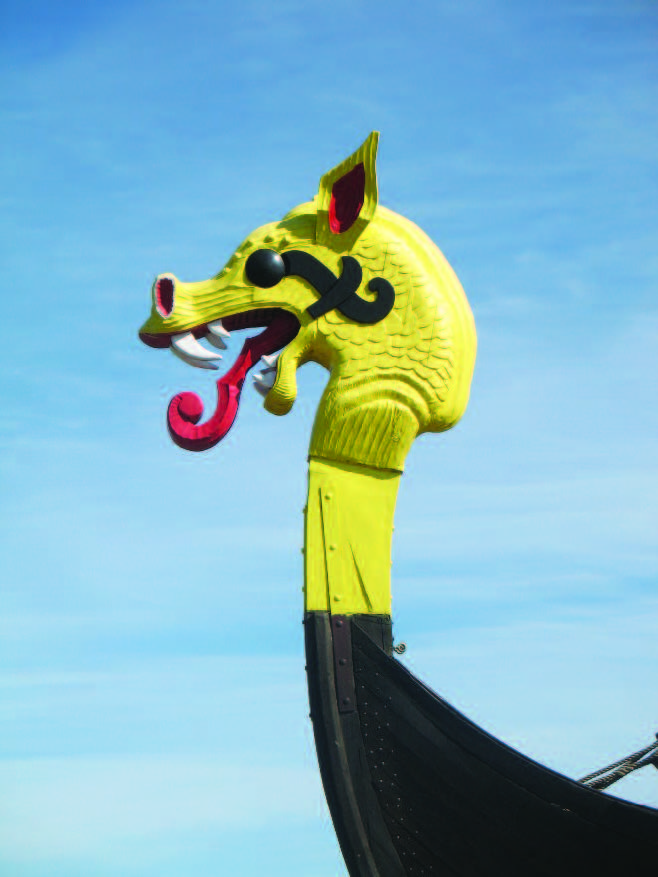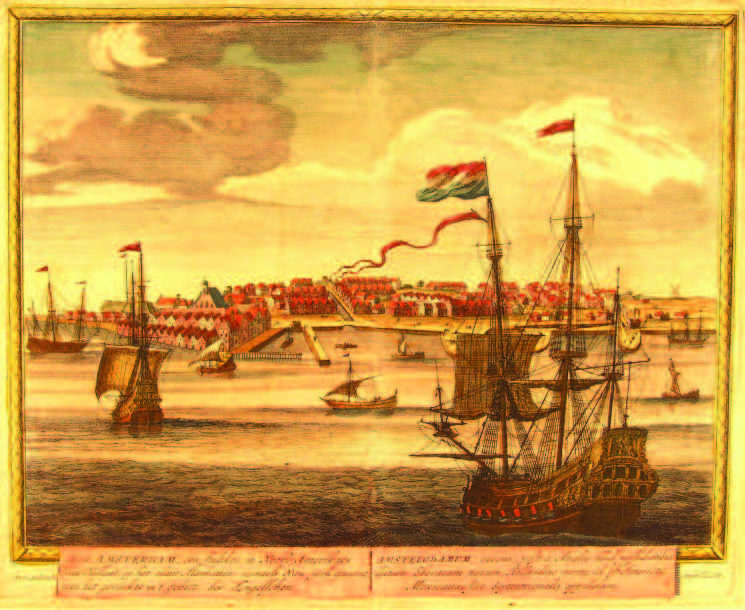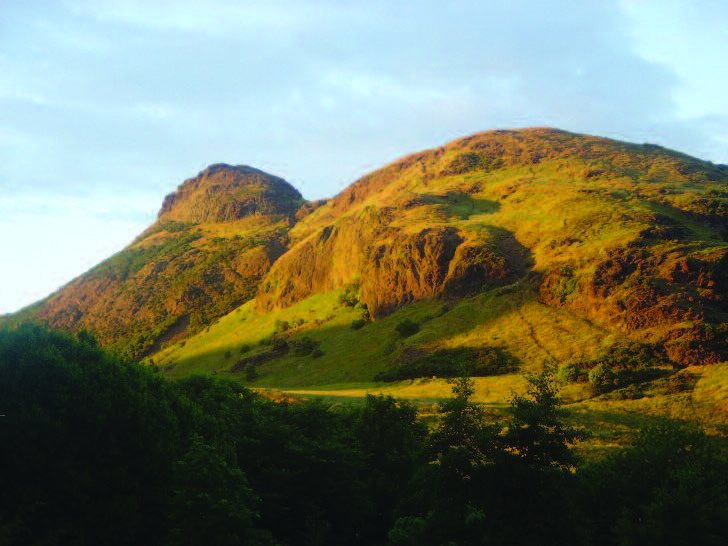
A mother and daughter trace their roots to the Vikings—and to those they conquered
“You would run for your life,” my daughter said. “You would grab a few precious things and run as fast as you could.”
We were traveling by train along the English coast, bound for Edinburgh in Scotland. The sun was glinting on the North Sea, and we looked across it in the general direction of Denmark, the homeland of my mother’s parents. My daughter, who was studying medieval history in graduate school, was describing what it would be like to live in an English coastal village in the Middle Ages, and to see Viking sails on the horizon.
She grew up hearing that her American mother was a proud descendent of Vikings, and not just any old raiders, but nobles. How could we know this? And why take such pride? Maybe it was because we are American and have few reminders of Viking raids.
Although both her parents came from Denmark, my mother grew up on the Great Plains of western Nebraska. She inherited this story from her mother, who probably inherited it from hers and so on. My heart twisted to remember how frail and sad my mother became in what I call her reclining years because she spent her days curled up in a big leather recliner by the window. Although she lived in Florida, it was as if a Nordic winter had come over her and never lifted.
Still, she smiled whenever the subject of Vikings came up. Yes, they were wild. Yes, they sacked monasteries. But they were family and lovable. This was the attitude. She saw their strengths as well as their weaknesses. They were brave and adventurous and possibly they had Seasonal Affective Disorder, like she and others in our family. Think of how they suffered during those long dark winters.
As the train rolled along the coast, I told Alex that after my mother died I dreamed of a Viking funeral. I stood on a beach in Florida, watching a ship containing her body glide into the sunset. Certain metaphors seem built into these bodies and hearts, I told her, inherited from ancestors for whom the unknown really was beyond the horizon.
Our ancestors live on in us, in our DNA. This brain and heart and body are structurally the same as those possessed by human beings 150,000 years ago. Our fundamental experience must be the same. Perhaps this deep commonality is why we sometimes feel the presence of loved ones.
My father had died a few months before and my daughter, who lives in England, arranged the trip as a way for us to be together and also as a pilgrimage. We were going to see Scotland, homeland of some of my father’s ancestors, birthplace of his last name, and a place he had never been. We were going to stand on the land and look out at the hills and think about the lives they lived.
Alex loved her grandfather and lovingly planned this adventure as a balm for grief. But immediate family is one thing and ancestors another. She wondered why Americans seem to be so interested in discovering their ancestry. Especially because my father’s ancestors were among the earliest European settlers of New York, and I still was a New Yorker. Wasn’t that place in particular the island of misfit toys, the place people came to escape the limitations and expectations of their families and hometowns? Why look back?
We need roots and connection, I told her. For every American this is so, I thought, for those who came here seeking freedom and for those who came in chains. People want to know where we came from, to be rooted in a deeper truth.
The sun sparkled on the North Sea. I was filled with a sense of the poignancy of life, the relentless way things and people are lost. I needed to say more. Don’t try to compare your life to the life a younger person, I thought. This I knew. Even people who really love each other can’t really understand what another experiences. But don’t hesitate to share your own deepest experience. As we age, we have quite a lot of it.
As the train left the coast and headed north, I told Alex about a dream that was more than an ordinary dream. It happened years before, at a retreat center in California. The evening of the dream, in a big meditation hall, a heated argument broke out about injustice. Disheartened, I left and went to bed, wondering how the wounds in this country could ever heal.
I woke up in another body, in another time and another place. I stood on the bow of a long ship approaching a foreign shore. My body was different, bigger and stronger. But I was in that body, sensing the cold salt air on my skin, watching dawn wash the sky with color and light. The ship cut swiftly through the water. As we drew close to shore, I could see people standing and waiting amidst dark trees.
My heart glowed like an ember, commanding my attention. This time would be different. I would take off the armor and put down the sword. I would open to receive what came instead of rushing in to take. The people on the shore stood watching, as tall and rooted as the trees. They were not running. I felt the others behind me in the ship, watching. It was a seemingly small act, opening a heart. But it was a momentous change.
The train crossed the border into Scotland. Alex looked like she didn’t know what to say. I pressed on. After this dream, I realized that I could make amends in this life. I could learn to take off my armor to open my heart and mind. This body, this heart, this brain, come to us from the ancestors. In a very real sense, they live in us.
We don’t see this because we believe that time is linear, endless forward progress instead of cycles within cycles, day and night, seasons, heartbeats, breaths. The great Zen sage Dogen said that when we sit down to practice, we sit down with the ancient ones, with the Buddha and all those who sought to wake up. They help us, and we help them.
The aboriginal people called modern people the “line people” because we believe time is linear. If we woke up from this trance, we would understand that time doesn’t exist in the way we think it does. We would understand that it is simply our turn to try. If this is true, we can repair the past, and prepare a new future. In this very moment, in this body, with this heart.
“Think of it this way,” I said to my daughter. “Have you had moments that seem to contain your whole life, moments in which everything you have been through seems to have been a preparation?” Alex nodded, smiling, possibly thinking of love.
“Maybe there are moments when others are present.”
“Possible,” said Alex, looking doubtful. The train rolled north into Scotland.“Actually, you’re a mix of oppressor and oppressed,” said Alex.
“Aren’t we all?” I asked. Still, I knew what she meant. According to Ancestry.com my DNA is 41% Scandinavian, 39 % British, 14% Irish, 4% Western European, 1% European Jewish, with a thrilling dash of Western Asia. My British-Irish blend paternal DNA was shared by people who were probably terrorized by the Vikings.
My 100% Danish mother possessed 9% non-Danish DNA, possibly related to some long ago raid on a coastal village, but maybe due to someone falling happily in love and assimilating. And certainly there were people who shared my British and European and drop of West Asian DNA who oppressed others. Everyone is mixed, I thought.
The burning question is, how do we connect with our deeper humanity? How do we grow down and take root so that we can experience ourselves as part of a greater cycle, member of a bigger family, not just someone carried along passively on a stream of change?
It doesn’t matter where we start, I learned. It only matters that we let the questions deepen. We can start with notions so literal and weak they make us wince to think of later. I once visited an outdoor event in lower Manhattan, for example, thinking this might help me enter into the experience of an early settler.

“This is New Amsterdam,” said the New York City cop, his face and voice deadpan, as if the big fake windmill looming up behind him should have given it away. I had taken the Metro North train down to Bowling Green Park in lower Manhattan to walk through what the New York Times said would be a colonial village with “12 traditional houses, a windmill and a greenhouse.” It was set up to celebrate the four-hundredth anniversary of Henry Hudson’s exploration of what would become the greater New York metropolitan area, and I knew it would be hokey. I knew there would be cheeses and little wooden shoes involved. Still, I pictured being able to walk through humble little cottages, places that might remind me what it was like to be here long ago. Instead, there were rows of little kiosks selling French fries, gouda, herring burgers, tulips, and, yes, little wooden shoes.
My father roared with good-natured laughter when I told him about the New Amsterdam adventure, reminding me that our ancestors didn’t stay long in Manhattan anyway. Deciding the land would never be worth much, they gave up their farms and migrated up the Hudson Valley, to the banks of the St. Lawrence River and Lake Ontario, tilling rocky little farms or becoming sailing captains on the St. Lawrence River.
“It takes a special talent for free white men to get here as early as they did and stay as poor as they did,” my father said.
Because my mother was from the Great Plains, her story of our noble Viking ancestors flowed in with images I had of the Plains Indians. I pictured the Vikings crossing the great water in open boats, living close to nature, honoring gods who represented great forces. Like the Blackfoot, Cheyenne, and Lakota tribes, they were warriors who lived in the natural world, in relationship with powerful forces. As a child, I made no distinction between continents. The big difference was between those whose lives included the body and nature, and those who left it behind.
In a sense, discovering our genetic DNA is like those marvelous stories about traveling the world only to find the treasure buried in your own backyard or in a chest under your own bed. And the ultimate trip came for me when I sent a scraping of cells from inside my cheek to the National Geographic “Genographic Study,” a genetic population study that is attempting to track the migrations of our earliest common humanity, based on the notches that get carved into our DNA as it is copied and passed down through the generations.
Months later, I received a world map that traced my matrilineal DNA back 150,000 years, to a woman in East Africa, our common genetic “Eve.” We are all family.
But it was equally astonishing to discover that my mother’s line belongs to “haplogroup X,” a group whose DNA possess markers with Lakota, Sioux, Ojibwa, Navajo, and other indigenous Americans. I pictured Plains Indians carrying long boats to the Great Lakes, sailing up the St. Lawrence and across the open sea, to Denmark, where they taught the prehistoric Viking warriors how to build long ships and sail across the open sea. The man I was in the vision and the people on shore were ultimately family. Everyone is related.
“Therefore, Ananda, be islands unto yourselves, refuges unto yourselves….” As he lay dying, the Buddha gave this advice to his beloved disciple Ananda. Facing death reveals the true nature of life. It passes. At times, it can feel as if we are being swept along.
When the Buddha spoke of being an island he didn’t mean be cut off from the flow of life. By being an island, he meant dare to touch the earth of your own living experience in the present moment. He meant dare to relax and travel from the surface to the depths, from thinking and emotional reactions to deeper human feelings and insights. He meant to sit down and join the circle. He knew that when we return to the life of the body, the basic experience of being here—breathing in and out, sensing the air on the skin and the beating heart—can often blossom into a feeling of how good it is to be here. He knew that the simple act of returning to the breath and the body can return us to the great cycle of nature and to the ancestors. It can remind us how amazing it is to be alive. We may have a feeling of basic communion with others who live.
I thought of my father at the end of his life. Blind from macular degeneration and tethered to oxygen, he talked about basic experiences of life, about spending summers on a farm and how happy commanding officers were during World War II when they found they had farm boys among their soldiers “because they know how to do things.” They knew how build shelters and fires, find water and true north. At end of his life, my father knew what really matters. “Just sit with me, honey,” he would say.
My father understood that no matter what is happening, we could sit down and be islands. Even with time rushing on, we can return to the basic experience of breathing in and out, hearts beating, being alive in the present moment.
“Isn’t life a ball?” he used to ask when confronted with some fresh evidence of absurdity. Even when things grew tough, he rolled with it. “I know I can’t go on forever but I would like to keep going as long as I can, just to see how things unfold.”
When we really understand that there is no escape from time’s passage, no escape from life, we may find ourselves bringing our whole lives to each moment. Sometimes, we may even feel as if our ancestors are with us, witnessing life through our eyes. We may see that this awareness itself is a gift and that we can give back. We can find freedom for ourselves and those who came before.

On the last day of our stay in Edinburgh, Alex and I climbed to the top of Arthur’s Seat, the main peak in a group of hills around Edinburgh, so named because it is claimed to be the location of King Arthur’s Round Table. “Do you feel anything?” Alex asked as we climbed. I told her I did but it wasn’t what she thought. My father was gone. My mother was gone. My daughter was grown up and moved to England. I thought of all of ancestors back and back and back, thought of all that came before, that we should be here.
At the summit Alex and I listened to the wind and voices of the climbers around us. All humans carry the DNA of ancestors who travelled a long way, who were pushed from their lands by famine or earthquake or war or a deeper yearning.
Einstein called our sense of separation from others an “optical delusion of consciousness.” He encouraged us to escape from this prison by “widening our circle of compassion, to embrace all living creatures and the whole of human nature in its beauty.” Nobody achieves this completely. “But the striving for such achievement is in itself a part of the liberation, and a foundation for inner security.”
I told Alex that my second cousin, who knows much about our family history, came to visit once and revealed that an ancestor in my mother’s family possessed a large estate in Denmark in the twelfth century. I asked him how this could be known, and he said there were deeds of land going back to the fifteenth century. Before that there were legends.
“He probably was a Viking,” said Alex. “In that period in Denmark, that was how a large estate was created.”
That very ancestor could have stood stood on the bow of a long ship. So could have the ancestors of my father. In a tourist shop in Edinburgh, we bought a pamphlet with a little plaid cover dedicated to the Cochrane clan (somewhere along the line the final “e” was dropped). Early on, the Cochrane clan was taken over by a Norseman. I had Vikings on both sides, as well as those they oppressed.
This probably wasn’t really the place of Arthur’s Round Table, Alex explained. And if there was any truth to the legend of Arthur, he wasn’t a knight in shining armor or a king in a grand castle, but an earlier kind of warrior chief, living a life that was much more simple and elemental. I sat and listened quietly, open to the wind and the possibilities. ♦
From Parabola Volume 42, No. 4, “Families,” Winter 2017-2018. This issue is available to purchase here. If you have enjoyed this piece, consider subscribing.
